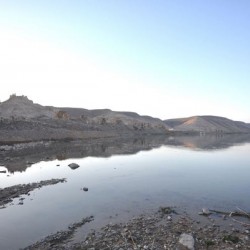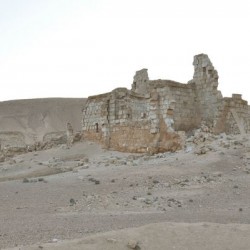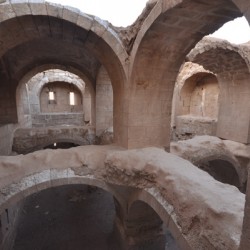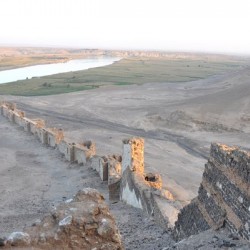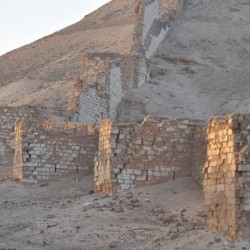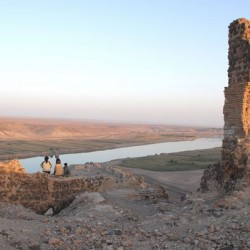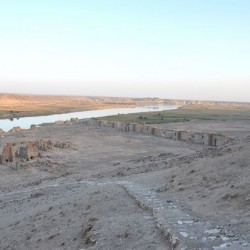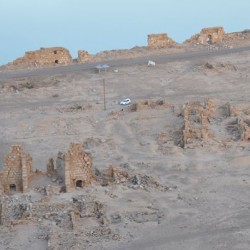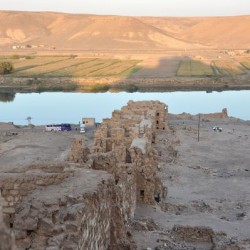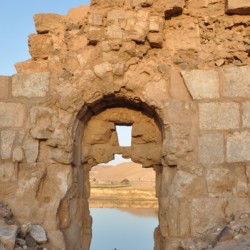Zenobia (Halebiye)
Q903630Zenobia: Byzantine fortress on the river Euphrates, modern Halebiye. Across the river is a second fort, now known as Zalebiye.
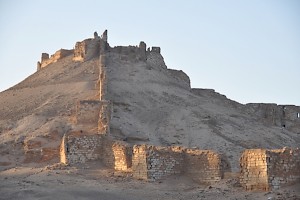
The river Euphrates was the shortest road from the Sasanian Empire to the Roman Empire. It was also one of the most accessible roads, because there was sufficient water for a big army. As a consequence, the Romans extended their presence along the river gradually to the east, to Dura Europos and beyond, until they had reached the area of Al Fuhaymi in Iraq, 140 kilometer east of Dura. However, the Sasanian king Shapur I captured many of these military settlements, including Dura, and even took the Roman emperor Valerian (260).
Roman rule in the east was now on the brink of collapse. There were several usurpations, but Odaenathus of Palmyra restored order, and was recognized by Valerian's son and successor Gallienus as dux Romanorum ("leader of the Romans"). In 266, he captured the Sasanian capital Ctesiphon, thus avenging the honor of Rome. One year later, he was killed and succeeded by his wife Zenobia and their son Vaballathus, who were less loyal to Rome: in 269, they broke with Rome, creating an empire of their own. The rebellion was suppressed three years later, by the Roman emperor Aurelian.
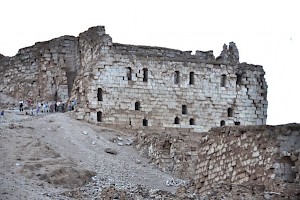
However, the presence of Roman legion on the banks of the Euphrates did not mean that everything returned to normalcy: the old lines of defense had changed, Dura Europos and other fortresses had been destroyed, and a new bulwark against the Sasanians had become necessary. It is in this context that Fort Zenobia was built, and named after the empress - perhaps by Odaenathus, perhaps by herself.
The site itself is indicative of a change in defensive system: it is behind the real frontier (which was at the river Khabur), as a kind of second line of defense. In other words, the Palmyrene rulers had abandoned the old limes system and replaced it with a system of defense in depth.
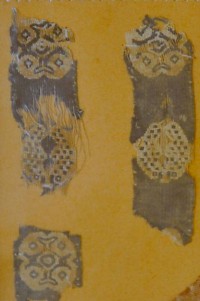
Although Rome was, at the end of the third century, generally in the offensive, the defenses were not forgotten. It is likely that Fort Zenobia was rebuilt by the emperor Diocletian (284-305); a second building phase took place when Anastasius I was ruler of the Byzantine Empire (491-518); the next rebuilding can be dated to the reign of Justinian (527-565), who sent his general Belisarius to the east to fight against the Persians. This building phase is described at some length by Procopius.note
The site must have been taken over by the Sasanians during their epic fight against the Byzantines in the first third of the sixth century, and may have remained abandoned when the emperor Heraclius reconquered Syria. The Arabs took over the area in 637, reused Zenobia, and modified the citadel, using older architectural elements ("spolia"). However, because both Syria and Iraq were both part of the Umayyad Caliphate of Damascus, the site had lost much its strategic importance, and the Muslim occupation did not last very long.
The site, which measures about twelve hectare, remains impressive: the fifteen massive towers and the Praetorium are almost intact, just like Justinian's walls. The southern wall is about 550 meter long and connects the citadel on the hill to the river; the northern wall is 350 meter long. The Praetorium is adjacent to the northern wall, halfway up the hill: a multi-storeyed building with a very large hall that would have been called a knight room in more recent fortifications.
Less well preserved are the 385 meter long wall along the river, which had to contain the Euphrates, the bathhouse, the palaestra, the governor's house, and the two basilicas. The East Basilica probably dates to the fifth century, the West Basilica was built by Justinian.
